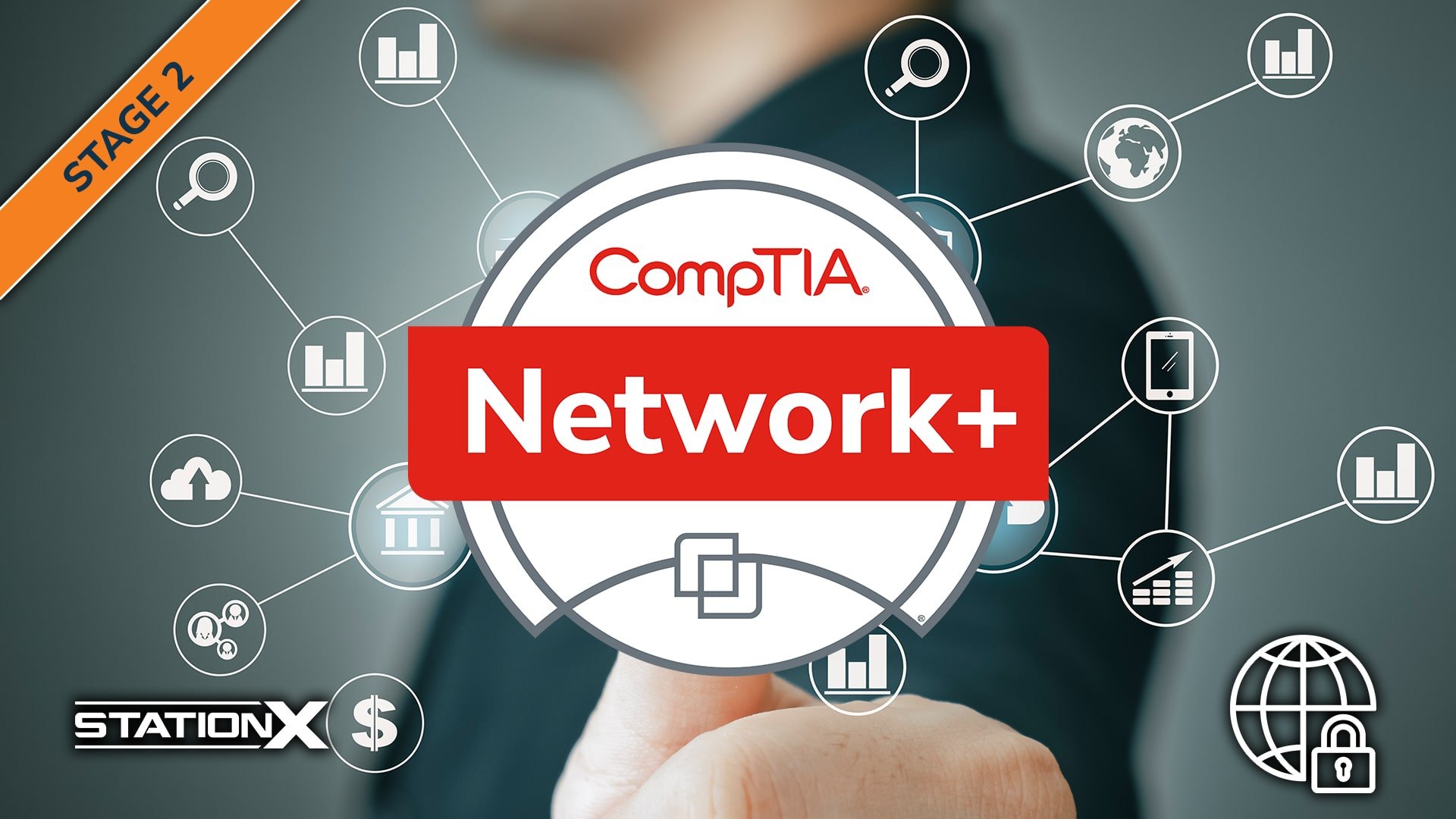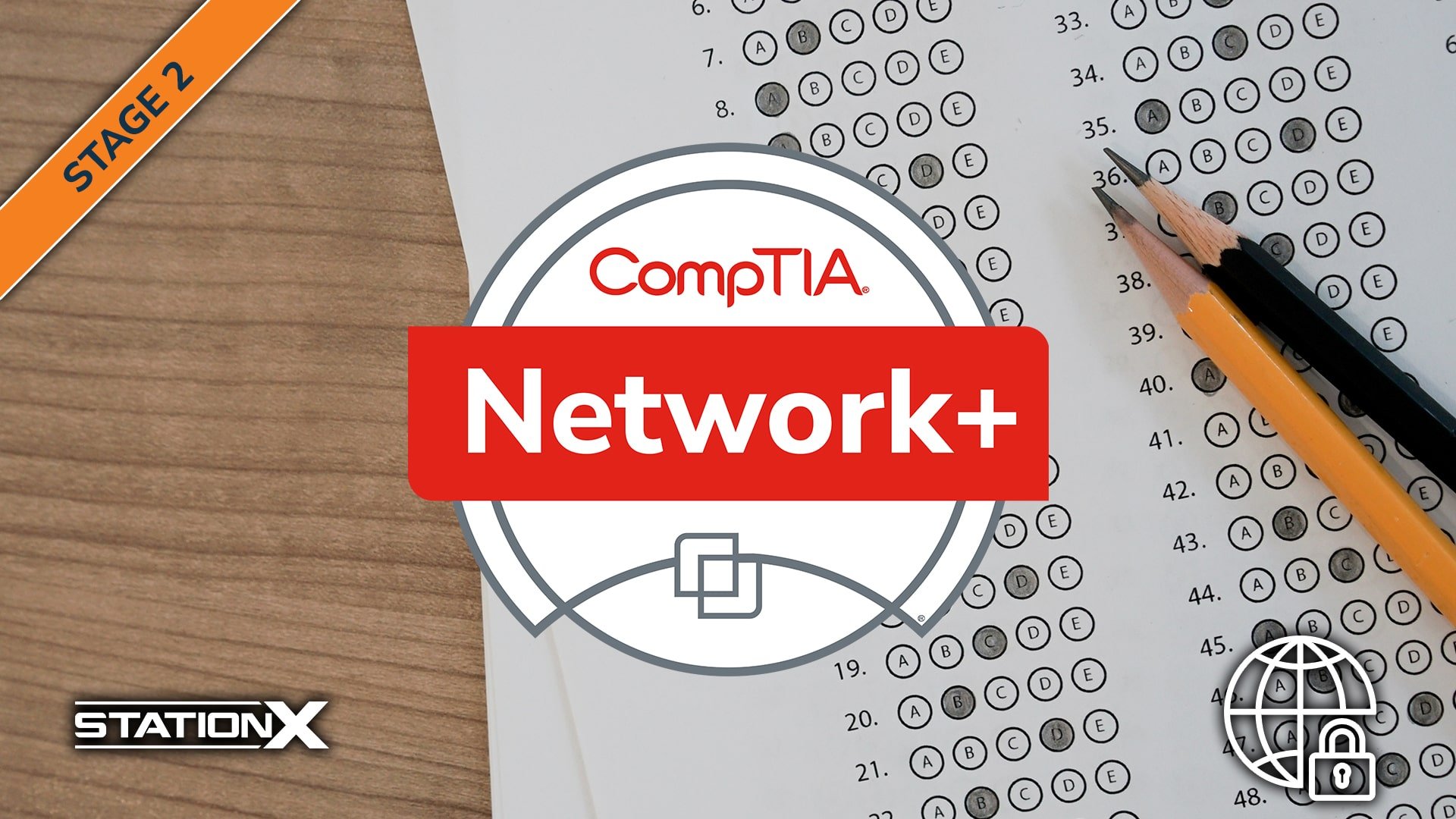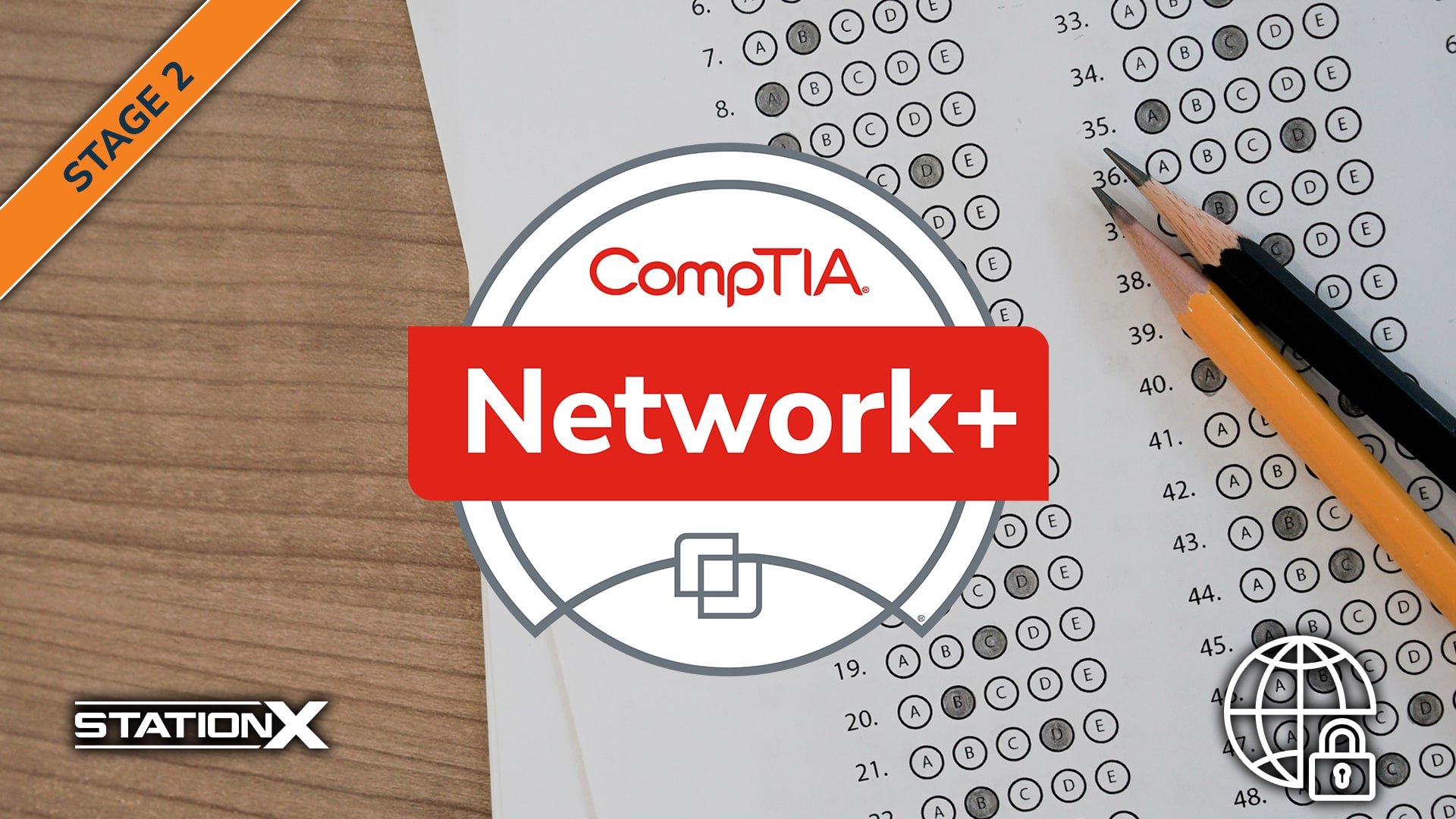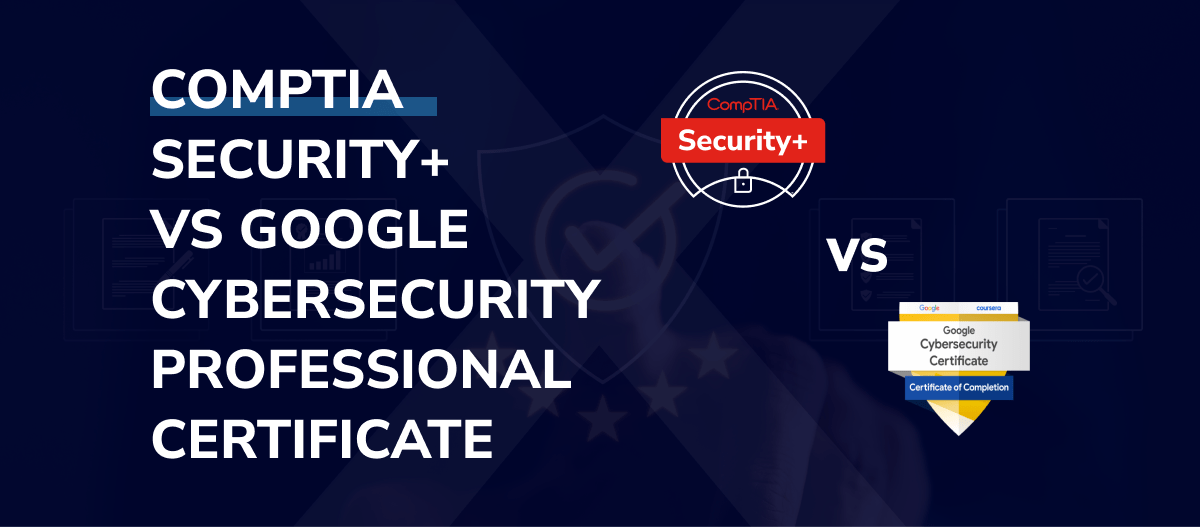The CompTIA Network+ certification is immensely helpful in your certification journey, especially because it builds a solid foundation for getting Security+.
However, an upcoming CompTIA Network+ update has thrown a wrench into your study plans. Should you take the familiar N10-008 or prepare for the new N10-009 instead?
Your study time dwindles with every moment of worry, but we’ve done the in-depth research for you.
In this article, we’ll discuss why CompTIA has such a Network+ exam update, the similarities and differences comparing CompTIA Network+ N10-008 vs N10-009, and changes to the Network+ syllabus.
After reading this article, you’ll know when taking the N10-008 vs N10-009 exam is a good idea.
Without further ado, let’s break down Network+ N10-008 and N10-009 before it’s too late.
Why the CompTIA Network+ Update?
Industry trends and standards change rapidly, and acceptable best practices in the past can easily become obsolete with new technological advances.
The rules for strong passwords have changed from including special characters to having a minimum length, and the rise of quantum computing threatens existing encryption algorithms that are otherwise proven secure.
Therefore, it’s crucial that industry-recognized certifications, such as those by CompTIA, remain up-to-date and reflect the current state of the tech industry.
That’s why CompTIA updates several of its exams, including Network+, roughly around a three-year cycle, adding items that the industry pays attention to and pruning away content that’s no longer relevant or necessary.
What Hasn’t Changed With the Network+ Exam Update?
The price of the Network+ N10-009 exam is the same as for N10-008. Each exam has at most 90 questions, including multiple-choice and performance-based items.
Both exams last 90 minutes, and their passing score is 720 on a scale of 100-900. Once you get your Network+ certification by taking either exam, it’s valid for three years following the exam date.
The troubleshooting methodology in both syllabi remains the same:
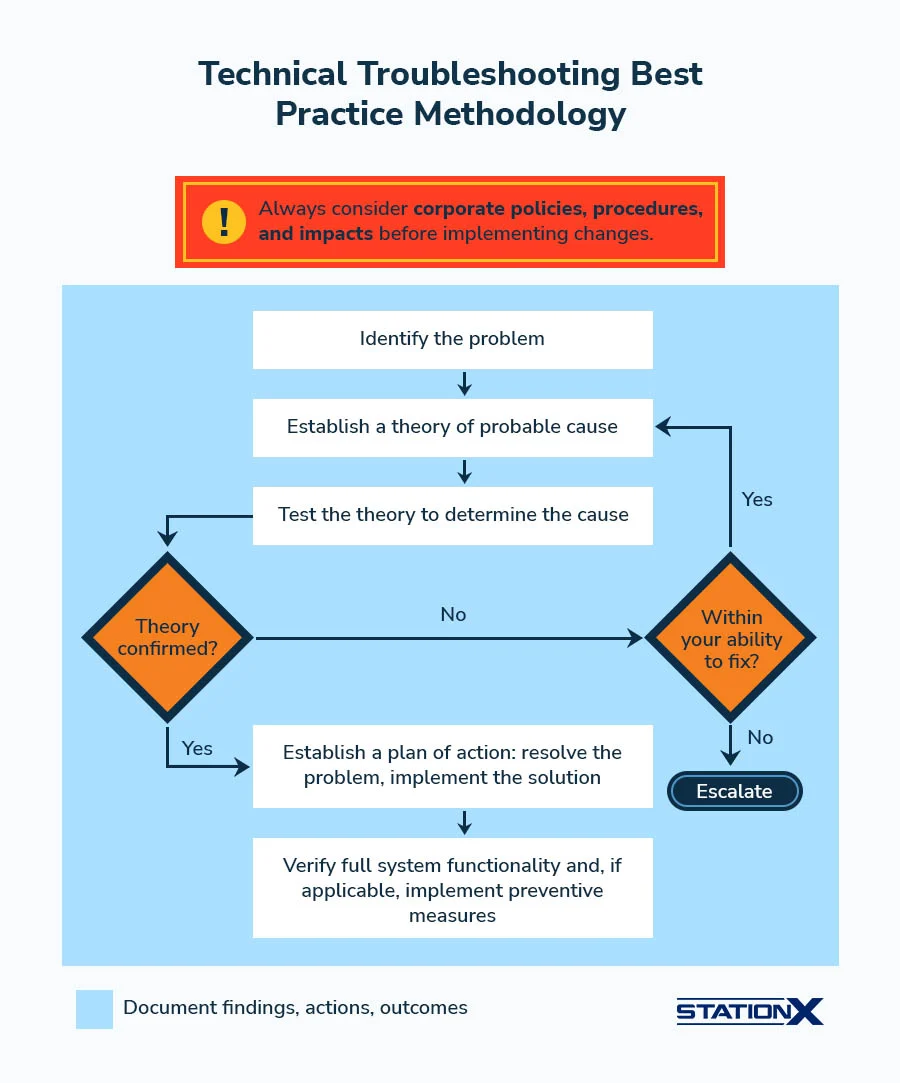
CompTIA Network+ N10-008 vs N10-009 Domains Compared
The first major difference between N10-008 and N10-009 is in the domain percentages. The exam objectives within each domain have also changed substantially, which we’ll explain below.
- Instead of Networking Fundamentals, we have Networking Concepts, and the weighting drops from 24% to 23%. This domain has the greatest alteration.
- Network Implementations loses the trailing “s,” becoming Network Implementation, and the weighting increments slightly from 19% to 20%.
- The Network Operations weighting rises from 16% to 19%.
- The Network Security weighting falls from 19% to 14%, corresponding to a significant reduction in exam content.
- The Network Troubleshooting weighting increases from 22% to 24%.
N10-009 reshuffles much of the content of N10-008, which explains the renaming of some exam domains.
Here’s a breakdown of the domain percentages in the Network+ N10-008 vs N10-009 exams:
| Domain # | N10-008 | Percentage | N10-009 | Percentage |
| 1.0 | Networking Fundamentals | 24% | Networking Concepts | 23% |
| 2.0 | Network Implementations | 19% | Network Implementation | 20% |
| 3.0 | Network Operations | 16% | Network Operations | 19% |
| 4.0 | Network Security | 19% | Network Security | 14% |
| 5.0 | Network Troubleshooting | 22% | Network Troubleshooting | 24% |


Still, the N10-008 vs N10-009 differences only begin here. Read on to find out what has changed.
What Is New to N10-009?
This section is an overview of Network+ N10-009 content not found in the Network+ N10-008 syllabus. We’ll use dotted domain numbers (such as 5.x) to refer to an official exam objective (“Network Troubleshooting”), specifying the exam code as necessary.
Networking Concepts
N10-009 has a much stronger emphasis on cloud concepts and connectivity options with these additional items:
- Network Functions Virtualization
- Virtual Private Cloud (VPC)
- Network Security Groups
- Network Security Lists
- Cloud Gateways
Another important new addition is the Internet Key Exchange (IKE) (1.4).
Bayonet Neill-Concelman (BNC) is officially on N10-009’s list of cables and transmission media (1.5), whereas it only resided in N10-008’s Acronyms.
Network Implementation
The increment in the weighting of this domain suggests you’ll need more comprehensive networking knowledge, especially in terms of network architecture.
Instead of comparing and contrasting routing technologies (N10-008 2.2), you’ll explain their characteristics (N10-009 2.1).
The latest wireless standards and technologies are part of the N10-009 syllabus, such as the 6GHz frequency and pre-shared key (PSK) vs. Enterprise authentication (2.3). You’ll have to explain important factors of physical installations (N10-009 2.4).
Network Operations
In N10-009, you’ll have to apply what you know about IPv4 and IPv6 network services (3.4), originally book knowledge (N10-008 1.6), to scenarios involving network infrastructure.
Network Security
The network security concepts in N10-009 overlap more with the existing Security+ SY0-701 syllabus than in N10-008.
Some content that belonged to this domain in N10-008 has moved to the Network Operations domain in N10-009. Check out the new focus on connection methods such as GUI and API (N10-009 3.5, N10-008 4.4).
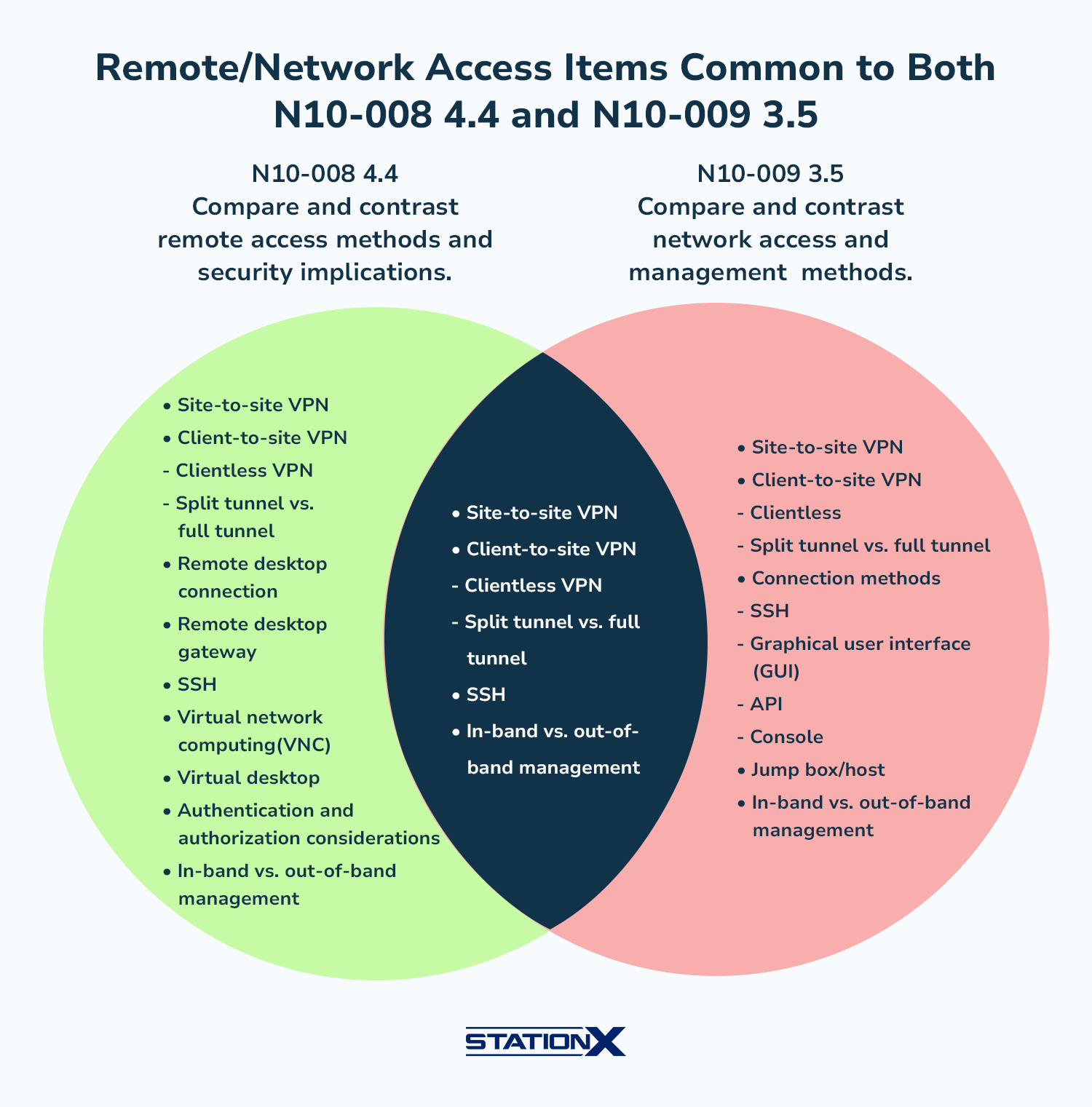
Network Troubleshooting
Watch out for additional considerations in troubleshooting cabling and physical interface issues (5.2 in both exams), such as increasing interface counter and port status.
There are more hardware tools but fewer network connectivity commands and command line tools (N10-008 5.3, N10-009 5.5).
N10-009 reclassifies networking problems under exam objectives, which differ from where they belonged in N10-008. For example, wireless connectivity issues (N10-008 5.4) partly become performance issues (N10-009 5.4).
Acronyms
The spelling and hyphenation of other terms differ between N10-008 and N10-009. Below, you can find a non-exhaustive list of examples:
- “BNC” loses the meaning of “British Naval Connector.”
- “MAC” no longer means “Medium Access Control.”
- “NIC” becomes plural, so no more “NICs.”
- “PTR” is “Pointer” in N10-009 vs N10-008’s “Pointer Record”
- The “I” in “RIP” is “Internet” in N10-008 but “Information” in N10-009
- “SC” isn’t “Standard Connector” anymore
- “SDWAN” becomes “SD-WAN”
- “ST” doesn’t mean “Snap Twist” anymore
- The “T” in “UTP” is “Twisted” in N10-009 instead of “Twister” in N10-008
Here are the new acronyms on the N10-009 list:
| Acronym | Spelled Out |
| A | Address |
| API | Application Programming Interface |
| BSSID | Basic Service Set Identifier |
| CDN | Content Delivery Network |
| CDP | Cisco Discovery Protocol |
| DAC | Direct Attach Copper |
| DAS | Direct-attached Storage |
| DCI | Data Center Interconnect |
| DNSSEC | Domain Name System Security Extensions |
| DoH | DNS over Hypertext Transfer Protocol Secure |
| DoT | DNS over Transport Layer Security |
| DR | Disaster Recovery |
| EAPoL | Extensible Authentication Protocol over LAN |
| EOL | End-of-life |
| EOS | End-of-support |
| ESSID | Extended Service Set Identifier |
| EULA | End User License Agreement |
| FC | Fibre Channel |
| GDPR | General Data Protection Regulation |
| GUI | Graphical User Interface |
| IaC | Infrastructure as Code |
| IAM | Identity and Access Management |
| IIoT | Industrial Internet of Things |
| IKE | Internet Key Exchange |
| IPAM | Internet Protocol Address Management |
| IS-IS | Intermediate System to Intermediate System |
| LLDP | Link Layer Discovery Protocol |
| MFA | Multifactor Authentication |
| MPO | Multifiber Push On |
| NTS | Network Time Security |
| OS | Operating System |
| OSPF | Open Shortest Path First |
| OT | Operational Technology |
| PCI DSS | Payment Card Industry Data Security Standards |
| PKI | Public Key Infrastructure |
| PTP | Precision Time Protocol |
| RFID | Radio Frequency Identifier |
| RSTP | Rapid Spanning Tree Protocol |
| RX | Receiver |
| SAML | Security Assertion Markup Language |
| SASE | Secure Access Service Edge |
| SMTPS | Simple Mail Transfer Protocol Secure |
| STP | Shielded Twisted Pair |
| SVI | Switch Virtual Interface |
| TX | Transmitter |
| TXT | Text |
| UTM | Unified Threat Management |
| VLSM | Variable Length Subnet Mask |
| VPC | Virtual Private Cloud |
| WPS | Wi-Fi Protected Setup |
| VXLAN | Virtual Extensible LAN |
| ZTA | Zero Trust Architecture |
Proposed Hardware and Software List
Here are the additions (as phrases) and changes (in complete sentences) to this list for the Network+ N10-009 exam.
- Equipment:
- Unlike in N10-008, where you’d need all three, you have options among the Layer 3 switch, managed switch (in N10-008’s Spare Hardware), and PoE switch.
- Spare hardware:
- NIC now means multiple network interface cards.
- Spare parts:
- Patch cables fall under two general categories: fiber and copper.
- Regarding the adapters for console cabling changes, instead of going from RS-232 to USB, they go the other way around, from USB to RS-232.
- Additional NIC/USB NIC
- Tools
- PoE Tester
- Software
- IaaS cloud lab/demo accounts
- Flow data analyzer
- Other
- Sample configuration playbook/runbook
What Has Been Removed Since N10-008?
It’s worth noting that Network+ N10-008 recommends “CompTIA A+ certified, or equivalent,” but it’s absent from the exam objectives for Network+ N10-009. This omission may mean that CompTIA is no longer concerned with prior training preparing you for Network+ N10-009.
The recommended amount of experience is still a minimum of nine to 12 months. Still, the emphasis has changed from N10-008’s specific “hands-on experience working in a junior network administrator/network support technician job role” to N10-009’s generic “experience in the IT networking field.”
Let’s move on to the removals in each domain by comparing the listed exam objectives.
Networking Fundamentals
As you may expect, antiquated material had to go.
Data encapsulation and decapsulation within the OSI model context (1.1 in both exams) isn’t part of N10-009; neither are the ports for POP3, IMAP, SQLnet, and MySQL or connectionless vs. connection-oriented considerations (N10-008 1.5, N10-009 1.4).
You no longer have to remember Ethernet standards, multiplexing, nitty-gritty cable specifications such as Cat 5, Cat 5e, and so on up to Cat 8, or cable management (N10-008 1.3, N10-009 1.5).
All terms that end with “area network,” such as “local area network” (LAN), “wide area network” (WAN), and so on, have vanished. The only exception is the “software-defined wide area network” (SD-WAN).
Virtual network concepts, service-related entry points such as smart jacks, and provider links such as digital subscriber line (DSL), have also disappeared (N10-008 1.2, N10-009 1.6).
Underused cloud concepts such as the community deployment model, Desktop as a Service (DaaS), and the security implications of cloud services didn’t make it into N10-009 (N10-008 1.3). Moreover, many IP network addressing concepts have disappeared (N10-008 1.4 and 1.8, N10-009 1.7).
The emphasis on networking devices and functions has shifted (N10-008 2.1, N10-009 1.2), with N10-009 having far fewer examples of networking appliances. For example, modems are absent in N10-009 1.2.

Network Implementations
The overall emphasis on network deployments has become less theoretical.
Ethernet is mentioned far fewer times in N10-009, which indicates that the exam no longer focuses on it—for example, in switching technologies and features (N10-008 2.3, N10-009 2.2).
Outdated wireless standards and technologies such as WPA, cellular technologies, and MIMO are gone (N10-008 2.4, N10-009 2.3).
Network Operations
N10-009 sharply deemphasizes high availability (HA), focusing instead on disaster recovery (3.3 in both exams). Many details in network performance monitoring are also gone.
Network Security
N10-009 excludes cyber attacks such as botnet/command and control, ransomware, password attacks, and piggybacking (4.2 in both exams).
You’ll need to crystallize network hardening techniques (4.3 in both exams) to more general concepts such as key management and zones.
The security implications of remote access methods, virtual network computing (VNC), and some remote desktop concepts (N10-008 4.4) are gone.
Physical security gets no mention in N10-009 (N10-008 4.5).
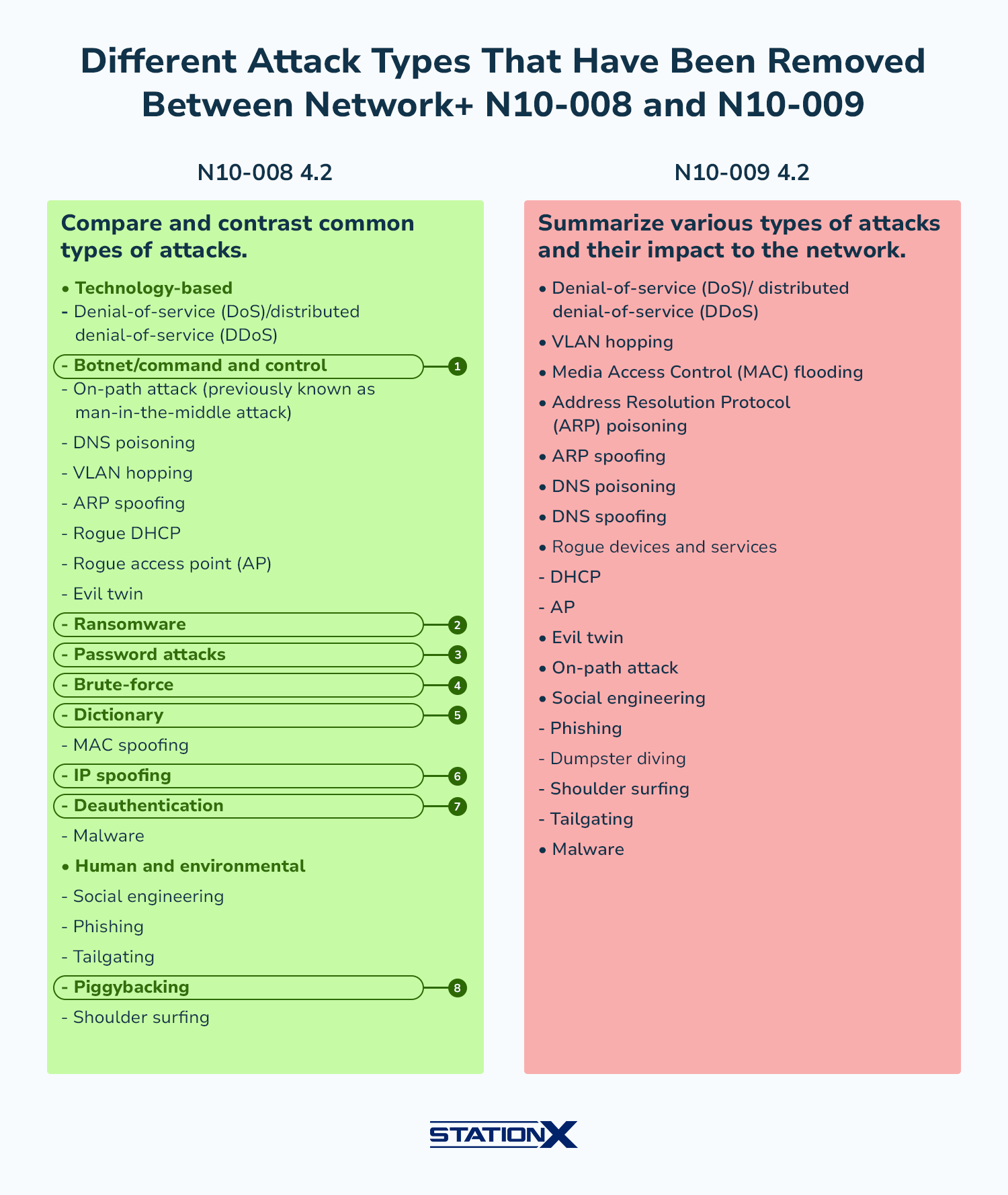
Network Troubleshooting
In troubleshooting cabling issues (5.2 in both exams), you no longer have to know the considerations of specific cables. You don’t need to state the tools for fixing cables, such as crimpers. Gone are the mentions of light-emitting diodes (LEDs) and decibel loss.
General networking issues (N10-008 5.5) dwindle to a handful of common ones (N10-009 5.3).
Acronyms
As a result of content removal, the following acronyms no longer appear on N10-009’s list.
| Acronym | Spelled Out |
| AAAA | Authentication, Authorization, Accounting, Auditing |
| AES | Advanced Encryption Standard |
| APC | Angled Physical Contact |
| CAN | Campus Area Network |
| CDMA | Code Division Multiple Access |
| CSMA/CA | Carrier-Sense Multiple Access with Collision Avoidance |
| CSMA/CD | Carrier-Sense Multiple Access with Collision Detection |
| CSU | Channel Service Unit |
| CVE | Common Vulnerabilities and Exposures |
| CWDM | Coarse Wavelength Division Multiplexing |
| DaaS | Desktop as a Service |
| dB | Decibel |
| DSL | Digital Subscriber Line |
| DSU | Data Service Unit |
| DWDM | Dense Wavelength Division Multiplexing |
| EIA | Electronic Industries Association |
| EIRP | Effective Isotropic Radiated Power |
| EUI | Extended Unique Identifier |
| FCoE | Fibre Channel over Ethernet |
| GBIC | Gigabit Interface Converter |
| GSM | Global System for Mobile Communications |
| HA | High Availability |
| HDMI | High-Definition Multimedia Interface |
| HVAC | Heating, Ventilation, and Air Conditioning |
| IGMP | Internet Group Management Protocol |
| IMAP | Internet Message Access Protocol |
| IPv4 | Internet Protocol version 4 |
| IPv6 | Internet Protocol version 6 |
| iSCSI | Internet Small Computer Systems Interface |
| ISP | Internet Service Provider |
| LED | Light-Emitting Diode |
| LTE | Long-Term Evolution |
| MAN | Metropolitan Area Network |
| mGRE | Multipoint Generic Routing Encapsulation |
| MIMO | Multiple Input, Multiple Output |
| MU-MIMO | Multiuser - Multiple Input, Multiple Output |
| MOU | Memorandum of Understanding |
| MPLS | Multiprotocol Label Switching |
| MT-RJ | Mechanical Transfer - Registered Jack |
| NDA | Non-Disclosure Agreement |
| NGFW | Next-Generation Firewall |
| OID | Object Identifier |
| OSPF | Open Shortest Path First |
| OTDR | Optical Time Domain Reflectometer |
| PAN | Personal Area Network |
| POP3 | Post Office Protocol version 3 |
| RA | Router Advertisements |
| RAID | Redundant Array of Inexpensive (or Independent) Disks |
| RFC | Request for Comment |
| RG | Radio Guide |
| RSSI | Received Signal Strength Indication |
| RTSP | Real Time Streaming Protocol |
| SOHO | Small Office Home Office |
| SRV | Service Record |
| SD | Solid-State Drive |
| STP | Spanning Tree Protocol |
| SYSLOG | System Log |
| TIA/EIA | Telecommunications Industry Association/Electronic Industries Alliance |
| TKIP | Temporal Key Integrity Protocol |
| TLS | Transport Layer Security |
| TX/RX | Transmit and Receive |
| UPC | Ultra-Physical Contact |
| VM | Virtual Machine |
| VNC | Virtual Network Computing |
| vNIC | virtual Network Interface Card |
| VRRP | Virtual Router Redundancy Protocol |
| WAP | Wireless Access Point |
| WDM | Wavelength Division Multiplexing |
| WLAN | Wireless Local Area Network |
Proposed Hardware and Software List
The following items are gone:
- Equipment:
- Punchdown blocks
- Layer 2 switch
- VPN headend
- Tablet/cell phone
- Spare hardware:
- GBICs
- Managed switch → Equipment in N10-009
- Spare parts:
- Specific names for copper cables (e.g., RJ11, RJ45, etc.) and the word “connectors”
- Tools:
- Telco/network crimper
- Punchdown tool
- Cable stripper
- Coaxial crimper
- Wire cutter
- Fiber termination kit
- Software:
- DHCP service
- DNS service
- NetFlow analyzer
- Firmware backups for upgrades
Should I Take N10-008 vs N10-009?
Based on what you’ve read above, is it more advisable to take the N10-008 exam or wait for the N10-009?
It’s only prudent of you to take whichever exam has the most available training material, including textbooks, courses, and practice tests to aid your studies.
Since the N10-008 exam has been around since September 2021, you have access to more study materials, which makes exam preparation easier, especially if you’re already studying for Network+.
Therefore, if it’s not too late in the year, seize the day and prepare for the Network+ N10-008 certification exam before it expires in December 2024.
Conclusion
We’ve given you an essential overview of the CompTIA Network+ N10-008 vs N10-009 exams, hopefully alleviating your worries about the update.
We’ve shown you the changes in the exam objectives and domains and the reasons for the updates so that you can make a timely and informed decision on which Network+ exam to take, given your resources and time.
Unlike N10-008, N10-009 deemphasizes older technologies such as Ethernet, reorganizes network security concepts to other domains, and has new focuses on cloud concepts and connectivity.
No matter which exam you’ll choose, we’d love to wish you success in your CompTIA Network+ certification journey and beyond.
Now, you may be worried about staying on track. But what if you had ready-made training courses, consistent mentorship, mastermind groups, and an entire community rooting for you to get your Network+ certification as quickly as possible, especially before December 20, 2024, the day N10-008 expires?
We offer all of the above so that you can jump in immediately. Join our StationX Master's Program now and beat this race against time starting today.

